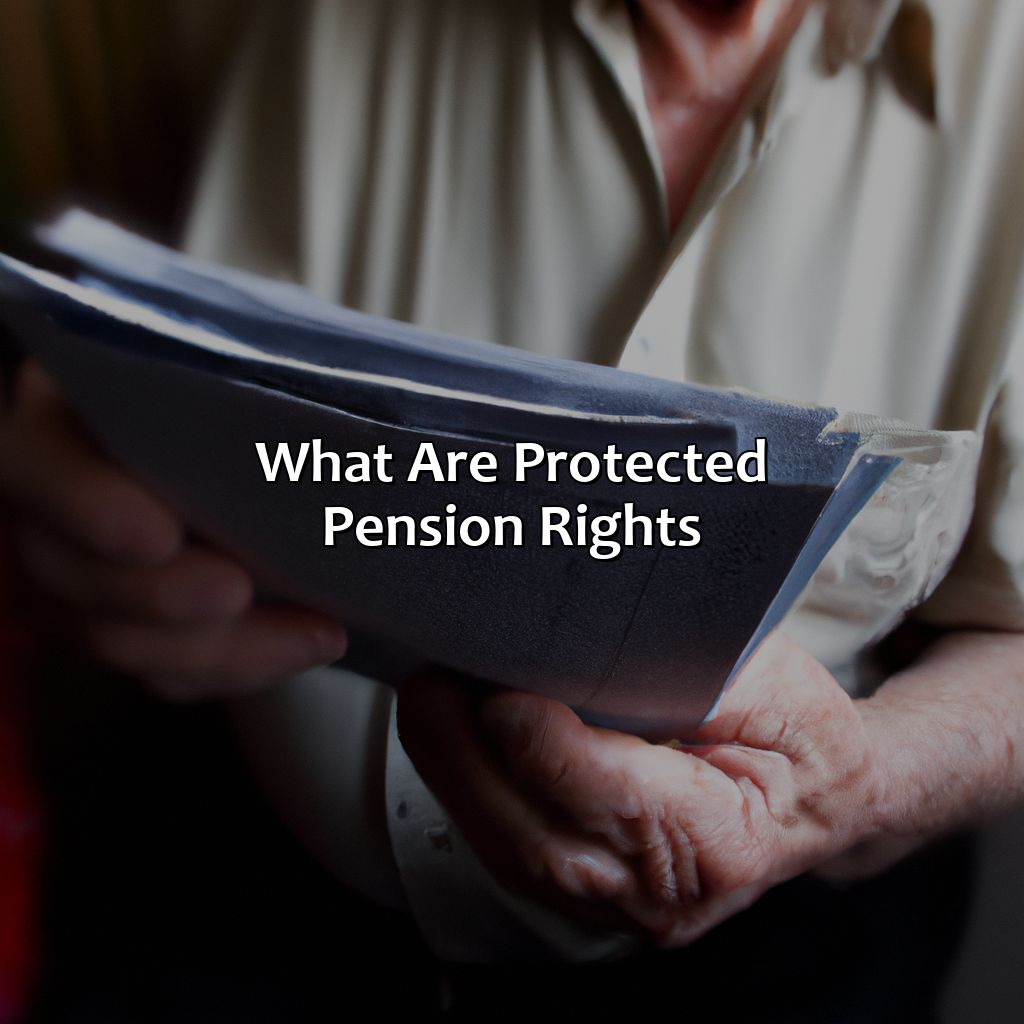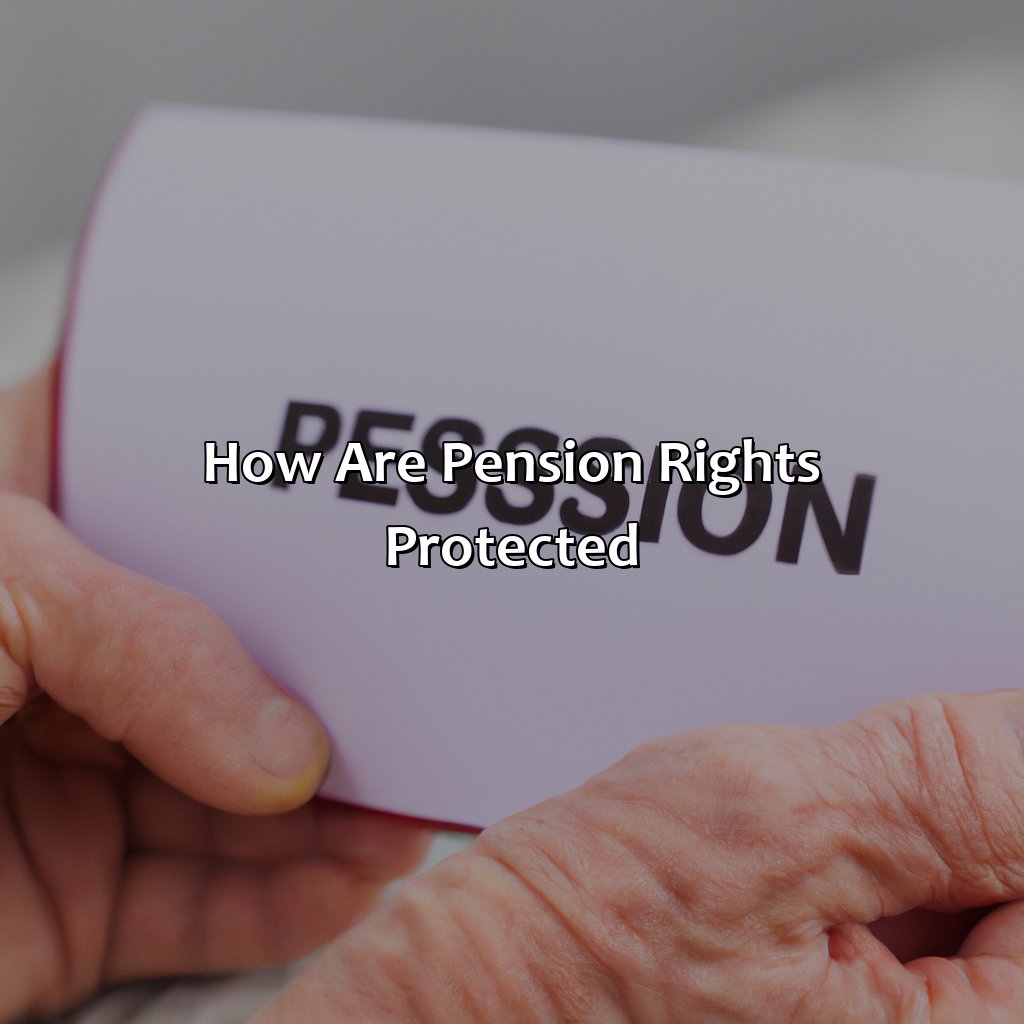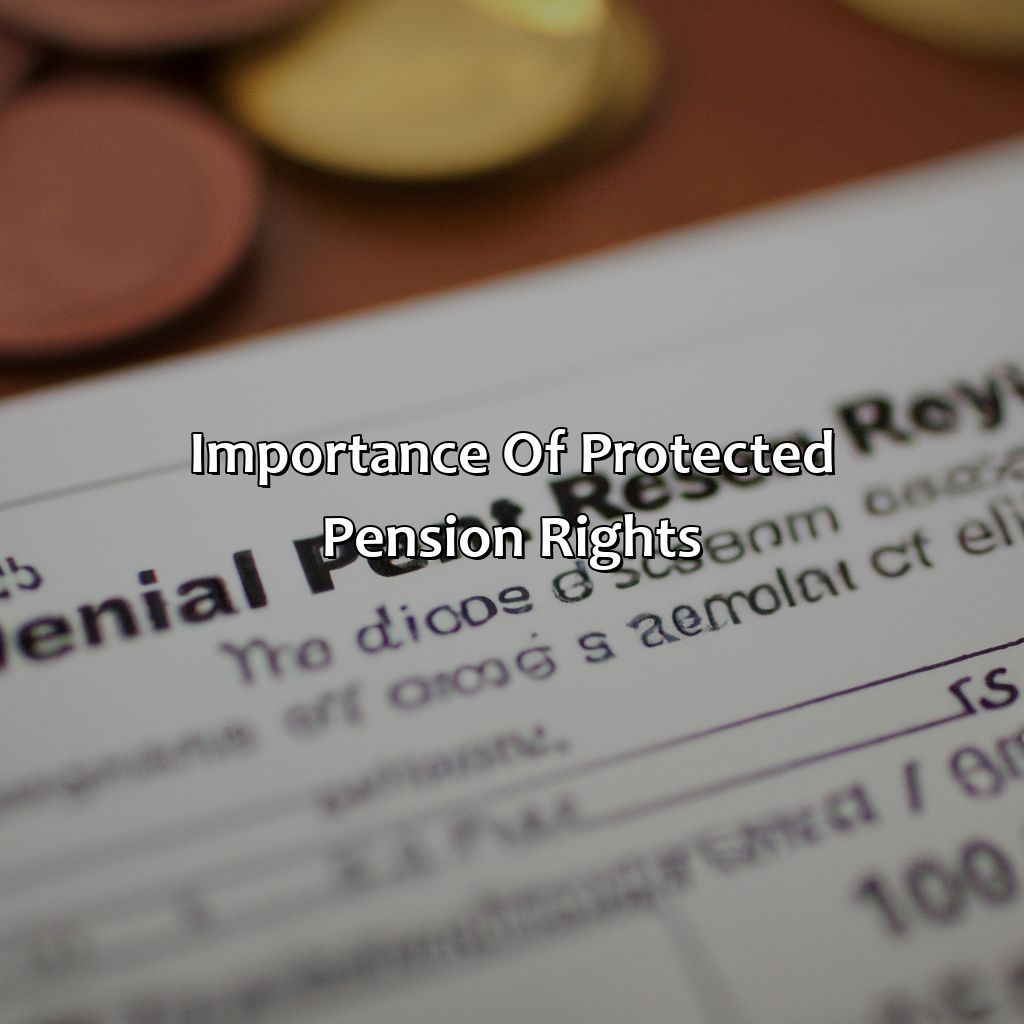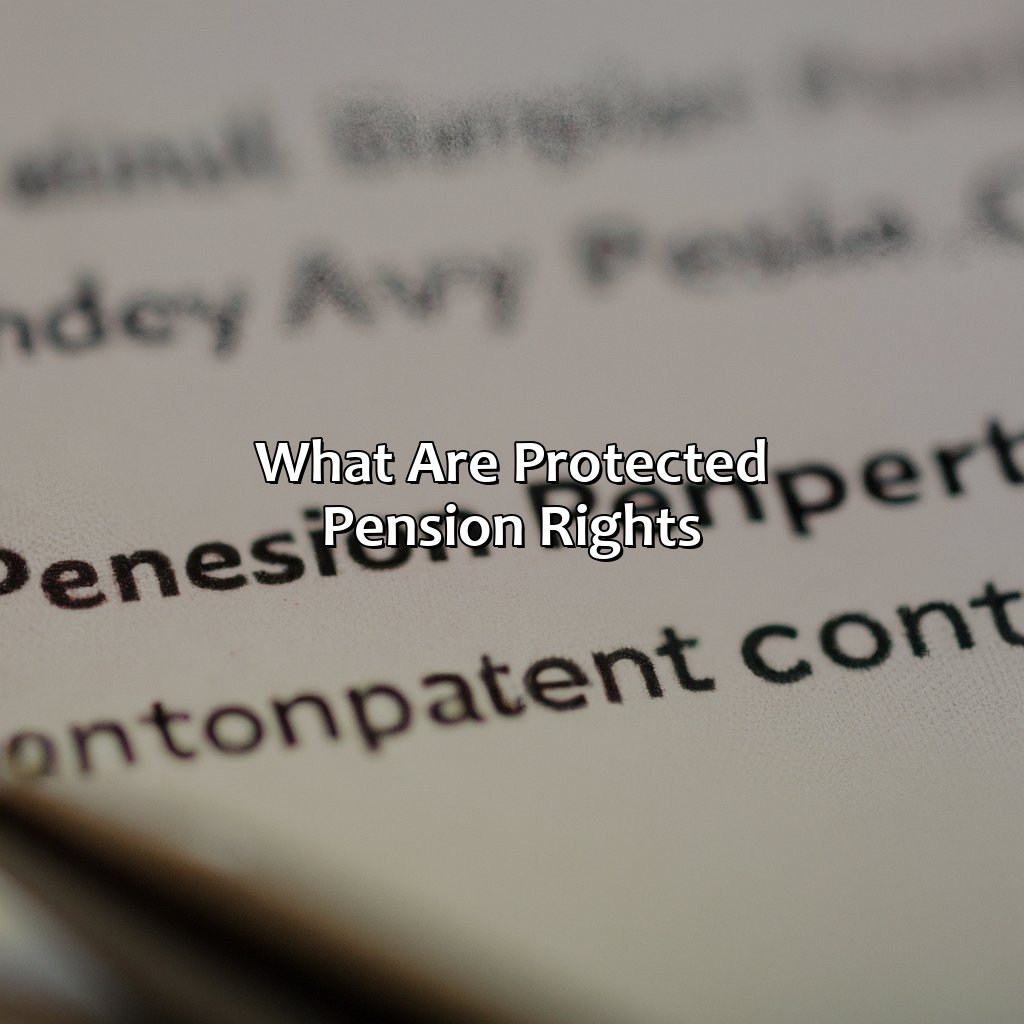What Are Protected Pension Rights?
Key Takeaway:
- Protected pension rights refer to legally upheld entitlements to retirement benefits, which are safeguarded by various laws, regulations, and insurance guarantees. These rights exist to ensure that after decades of work, employees can count on receiving adequate retirement income.
- The protection of pension rights is crucial to secure the future of pensioners, employers, and the economy as a whole. By ensuring that pensioners have access to a reliable source of income, employers can attract and retain a skilled workforce, and the economy benefits from increased stability and consumer spending.
- To ensure that pension rights are protected, governmental laws and regulations, pension schemes and sponsors, and insurance guarantees all play important roles. It is essential for all stakeholders involved to work together to create a sustainable pension system.
Are you unsure what your pension rights are? Discover what’s protected and what isn’t, so you can plan for a secure retirement. With the right knowledge, you can ensure a financially safe future.
What are Protected Pension Rights?
To figure out what protected pension rights are, take a look at the past, types, and definition. These bits (definition of protected pension rights, historical background of protected pension rights, types of protected pension rights) will give you lots of info on how they formed and what advantages they bring.

Image credits: retiregenz.com by Harry Washington
Definition of Protected Pension Rights
Protected Pension Rights are a set of legal provisions that safeguard an individual’s rights to receive pension benefits from their employer or government. These protections ensure that the pension plan remains in force, even if the employer goes bankrupt or the pension fund has insufficient funds to cover the pensions owed.
Protected Pension Rights can apply to various types of pensions, such as defined benefit or defined contribution plans. In addition, these rights may differ depending on your employment status, such as full-time, part-time or self-employed.
One critical aspect of Protected Pension Rights is the protection against discrimination based on age, gender or any other grounds that are prohibited by law. This ensures that pension benefits cannot be denied to individuals based on discriminatory factors alone. If you are wondering who can buy your pension, it’s important to understand these protected rights.
A historical example of Protected Pension Rights occurred during the Great Depression in the United States. The passage of various social security acts ensured the protection and security of workers’ retirement pensions, preventing them from losing their pensions due to economic instability and market destabilization. Such measures provided essential support for enabling greater financial freedom after working years were over and therefore increased social mobility.
Protected pension rights have been around longer than the idea of retirement – because let’s face it, people have been avoiding work since the beginning of time.
Historical Background of Protected Pension Rights
Protected Pension Rights have historical roots in the 19th century, where social security and retirement benefits were virtually non-existent. Industrialization led to a shift from agricultural labor to factory-based work, making it challenging for elderly people to rely on their families for support.
The first measures towards pension protection were adopted by government entities that provided modest payouts to retired civil servants. However, private-sector workers did not receive similar benefits until later. In the United States, the Social Security Act of 1935 created provisions for pension plans and related rules and regulations designed for worker wellbeing. Learn more about pension reforms and protected pension rights.
To safeguard individual retirement security, Protected Pension Rights have been put in place with various implementations suitable for different contexts such as public, private or between countries based upon prevailing standards/practices there. Alongside these rights are tax incentives like deferred compensation and funding options including employer-funded pensions that offer access to growth opportunities like mutual funds, stocks or bonds.
Protection is paramount for senior citizens given that declining health plus increasing healthcare costs compound matters. Governments should implement continuous strategies toward financial stability while magnifying awareness about diverse ways people can save through prudent investment management, well-structured trust funds & extended personal savings schemes.
Pro Tip: Check with your HR department or tax advisor on how you might be able to leverage Protected Pension Rights – which act as an auxiliary layer of income post-retirement – alongside choosing a trusted plan provider who can answer any questions relating to compliance, taxes and exemptions involved with this decision process.
Your pension rights are so protected, they’re like a fortress – only instead of a moat, it’s full of legal jargon.
Types of Protected Pension Rights
Protected Retirement Income – An Overview.
Different types of pension rights are legally safeguarded from being tampered with or taken away. These protected retirement income sources include state pensions, defined benefit schemes, cash balance plans, and some forms of personal pensions.
| Types of Protected Pension Rights |
|---|
| 1. State Pensions |
| 2. Defined Benefit Schemes |
| 3. Cash Balance Plans |
| 4. Certain Personal Pensions |
State pensions are provided by the government, whereas employers manage defined benefit schemes and cash balance plans. Certain personal pensions fall under the category of protected income but only if they provide guaranteed annuity rates.
In a bid to avoid pension scams, the UK government created a compensation program aimed at protecting savers who lost their money as a result of nefarious activity.
A tale is told about an employee who had worked for over twenty years at a company with a defined pension plan that promised to pay out benefits upon retirement. The company unexpectedly went bankrupt and people assumed they would have nothing to show for their years of service. However, because the scheme was protected, employees received their full entitlement despite the company going bankrupt. Learn more about public pensions and protected pension rights.
Protecting your pension is like wearing a bulletproof vest to a meeting with your ex – it may not be stylish, but it’s definitely necessary.
How are Pension Rights Protected?
It’s key to know how your pension rights are kept safe. Look at the solutions available!
The title “How are Pension Rights Protected?” and its sub-sections on:
- Government laws and regulations
- Pension schemes and sponsors
- Insurance and guarantees
will give you an idea of the ways your pension is secure and the choices you have.

Image credits: retiregenz.com by Harry Duncun
Governmental Laws and Regulations
The laws and regulations established by the government are designed to safeguard the rights of pensioners. These measures are in place to establish guarantees and protect pensions, which can be compromised due to various factors.
To ensure pension rights are protected, governments set out rules regarding the creation of pension schemes and how they operate. Scrupulous oversight is then carried out to ensure that these schemes comply with these standards.
Governments also provide mandatory protection for certain pension benefits such as the right to receive payment at a particular age or after a minimum service period has been satisfied. They may also regulate investment strategies adopted by pensions funds, mandates and other assets held by them.
In light of these measures, we heard of a story where an employee worked hard for 30 years at a reputable firm but was only entitled to minimal retirement benefits. Thanks to newly introduced governmental regulations advocating for fairer treatment towards Pensioners, he was able to contest his underwhelming provisions and obtained what he should have rightfully received from his employer all along. If you’re wondering what will be your state pension entitlement, it’s worth researching your options and understanding your rights as a pensioner.
You can’t choose your family, but pension schemes and sponsors can definitely make you feel like you’re stuck with them.
Pension Schemes and Sponsors
Pension schemes rely on sponsors to provide support and funding. Protecting these schemes requires a clear understanding of their structure and liabilities. Companies must adhere to regulations, such as contributions, governance and vesting requirements, to safeguard pensions. Additionally, pension trustees must monitor the scheme performance and communicate any issues with stakeholders.
Notably, recent changes have seen increased focus on member protection, including pension scheme consolidation through regulated master trusts and stronger regulatory oversight of defined benefit plans. Such measures aim to strengthen security for members while balancing this against sponsor affordability.
Historically, during the 1980s recession in the UK, it became evident that pension funds could be vulnerable if sponsoring firms failed. In response, the government introduced a statutory compensation fund that guarantees certain aspects of failed defined benefit pensions.
Your pension may be protected, but when it comes to insurance and guarantees, it’s always better to be safe than sorry.
Insurance and Guarantees
Pension guarantees ensure that retirees have security in their retirement. These guarantees provide peace of mind knowing that their pensions are protected. In the event of a company’s bankruptcy or pension plan termination, these guarantees protect the employee’s benefits.
In addition to insurance and guarantees, pension rights may also be protected by legal regulations and oversight boards. Regulations such as ERISA and PBGC regulate the management and payment of certain pension plans, ensuring that employees receive what they are rightfully owed. If you’re wondering what pension de-risking is, it’s a strategy used by some companies to shift their financial risk onto a third party, such as an insurance company, in order to reduce their own financial liability.
It is crucial to note that different countries have varying laws concerning pension protection. For instance, in the United States, multi-employer plans are eligible for federal financial assistance when facing challenges such as insolvency or underfunding.
According to data from the Pension Benefit Guaranty Corporation (PBGC), roughly 76% of single-employer defined benefit plans were fully funded in 2021.
Source: https://www.pbgc.gov/
Your retirement savings might be more protected than your heart in a relationship, thanks to protected pension rights.
Importance of Protected Pension Rights
It is key to grasp the significance of safeguarded pension rights and its subsections. These subsections present distinctive solutions for different people involved. For instance, they give financial stability to pensioners, cut down financial hazards for employers and energize the entire economy.

Image credits: retiregenz.com by Joel Washington
Benefits to Pensioners
Pensioners can enjoy various advantages due to their protected pension rights. These benefits guarantee a worry-free retirement and provide financial stability, especially during situations that may lead to income loss.
- Adequate weekly or monthly payments
- Access to health care without exorbitant costs
- Protection against potential inflationary trends
Further, these rights are vital for the maintenance of a decent life standard during retirement. Pensioners with steady income streams have the freedom to focus on their personal interests and pursue various hobbies or other passions.
Protected pension rights date back centuries with Queen Elizabeth granting military pensions to soldiers who suffered injuries fighting in her wars. Over time, this concept expanded, and nowadays, most countries ensure that their senior citizens have access to fundamental rights concerning retirement finances and pensions.
Employers love protected pension rights almost as much as they love downsizing and denying their employees bathroom breaks.
Benefits to Employers
Protected Pension Rights for Employer’s Advantages
Protected pension rights can benefit employers in various ways. Here are a few benefits that employers can have by setting up protected pension rights for employees:
- Attract and Retain High-Quality Employees: With protected pension rights, employers can offer a more comprehensive benefits package that may attract high-quality employees to the organization. Additionally, by providing secure retirement options, employees are less likely to leave the company.
- Tax Benefits: Employers who set up employee pension plans may qualify for tax benefits such as reduced tax rates and deductions, ultimately lowering the company’s taxable income.
- Increased Productivity: Providing a protected retirement plan supports worker job satisfaction and reduces stress levels. This minimizes absenteeism and increases employee productivity.
- Legal Compliance: By providing a protective pension right, the employer complies with legal regulations set out by regulatory authorities. This not only mandates that companies provide these types of retirement plans but also shows genuine concern for the well-being of its staff members.
Employers must be aware of potential drawbacks while establishing safe pension rights policies. These risks include heightened legal obligations, potential administrative burdens, and financial costs. Find out what was the primary purpose of the Pension Protection Act of 2006 to learn more about protected pension rights.
To maximize the advantages mentioned above while mitigating any possible negative consequences, employers should consider working with financial advisors or pensions providers to help them choose investment options that match their business goals while also ensuring compliance with legal mandates. Protecting pension rights not only benefits retirees, but the economy as a whole – because a well-funded retirement leads to less reliance on government assistance and more consumer spending. Win-win!
Benefits to the Economy
The safeguarding of pension rights plays a crucial role in boosting the overall health of the economy. The protection of pensions ensures the security of retirement income, which promotes financial stability and confidence for individuals and businesses alike.
Protected pension rights prevent poverty in old age, making sure retirees do not rely on government assistance to make ends meet. This enables them to be productive members of society without being a burden on public resources. Learn more about pension scheme and how it can secure your future.
This has been demonstrated by various studies that support the positive impact protected pension rights have on national treasuries, as it reduces welfare spending and enables those who retire to spend money in their local economies, generating economic growth.
Interestingly enough, an analysis of 18 countries by the Organisation for Economic Co-operation and Development (OECD) found that a mere 10% increase in per capita pension wealth resulted in consumers increasing their expenditure by up to 0.7%.
Protected pensions also play a fundamental role in attracting and retaining employees within companies as part of their benefits package. These schemes can encourage employees to save more, reducing staff turnover while promoting loyalty amongst retained talent. If you want to learn more about how a pension works in the UK, check out our comprehensive guide.
In short, ensuring that we continue to prioritize protecting pension rights will be key to promoting economic stability while enabling people to retire with dignity.
Five Facts About Protected Pension Rights:
- ✅ Protected pension rights ensure that a person’s pension benefits cannot be taken away or reduced by their employer. (Source: Pensions Regulator)
- ✅ In the UK, there are two types of protected pension rights – protected rights and safeguarded benefits. (Source: Financial Times)
- ✅ Protected pension rights can be lost if a person moves their pension to a new scheme that does not offer the same level of protection. (Source: Money Advice Service)
- ✅ If a person’s employer goes out of business, their protected pension rights may still be safeguarded by the Pension Protection Fund. (Source: GOV.UK)
- ✅ It is important to understand the level of protection offered by a pension scheme before making any decisions about transferring or withdrawing pension funds. (Source: Which?)
FAQs about What Are Protected Pension Rights?
What are protected pension rights?
Protected pension rights are the benefits and contributions that an employee has earned through a workplace retirement plan that are shielded from being reduced or lost due to certain events such as bankruptcy, company mergers, or changes to the retirement plan.
What events trigger protection for pension rights?
Pension rights are generally protected if an employer declares bankruptcy, the employer merges with another company, or the retirement plan is terminated.
What types of retirement plans are protected?
Retirement plans that are covered by the Employee Retirement Income Security Act (ERISA) are generally protected, which includes most private sector pension plans and some government pension plans.
What are the consequences if pension rights are not protected?
If pension rights are not properly protected, employees may lose their earned benefits or have them significantly reduced. This can result in significant financial hardship for retirees who rely on those benefits as a source of income.
What steps can employers take to ensure pension rights are protected?
Employers can take steps such as properly funding the pension plan, complying with ERISA regulations, regularly monitoring the plan’s financial health, and properly communicating the plan’s benefits to employees.
What resources are available to employees who believe their pension rights have been violated?
Employees who have concerns about their pension rights can contact the Pension Benefit Guaranty Corporation (PBGC), the agency that insures private sector pension plans. They can also consult an attorney who specializes in retirement benefits or file a complaint with the Department of Labor.
